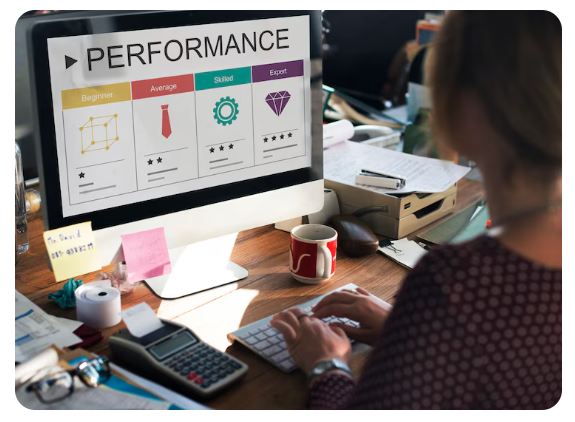Improving Workforce Efficiency: Trends and Innovations in The Future of Performance Management in Government
.jpg)
The Changing Landscape of Government Workforce Efficiency
All around the world, government agencies are rethinking how they structure their workforce. With citizens expecting more and bureaucratic slowdowns under increasing scrutiny, the push to enhance productivity in the public sector has never been more critical. Efficiency isn’t just a nice-to-have anymore; it’s essential.
The Crucial Role of Performance Management in Government Sector Transformation
To fulfill their responsibilities, governments need to move past outdated evaluation methods. Performance management has evolved from being a mere bureaucratic formality; it’s now a vital tool for ensuring accountability, fostering excellence, and aligning individual roles with broader public objectives.

Traditional Approaches to Employee Performance in Government
Paper-Based Reviews and Annual Appraisals
In the past, government departments depended on annual review cycles filled with paperwork, subjective comments, and slow feedback processes. This approach often missed the mark in capturing actual contributions, leading to disengagement and stagnation.
Inherent Limitations in Legacy Systems
Outdated hierarchies, a lack of digital tools, and isolated information made it hard to gain meaningful insights. The one-size-fits-all strategy overlooked the unique aspects of different job roles and stifled agility in workforce development.
Emerging Trends Shaping Performance ManagementContinuous Feedback and Real-Time Performance Assessment
Today’s performance management systems are all about ongoing feedback, moving away from the old-fashioned once-a-year review. Real-time assessments encourage responsiveness and give employees the timely input they need to adjust and thrive.
Data-Driven Decision Making in Human Resource Management
Analytics has become the backbone of modern HR strategies. When performance data is analyzed thoughtfully, it highlights top performers, identifies inefficiencies, and empowers leaders to make informed, unbiased decisions in workforce planning.
The Rise of Digital Solutions in Public Sector HRShift Towards Cloud-Based HR Software
Public agencies are increasingly embracing cloud-native HR software platforms, thanks to their scalability, security, and the ability to access them remotely. These platforms make it easier to implement integrated performance assessment systems that are both agile and straightforward to audit.
Customization and Automation: The New Imperatives
Today's HR tools are designed to meet the specific needs of government organizations—automating workflows, creating personalized review templates, and aligning performance cycles with departmental objectives.
Self-Assessment and Collaborative Review MechanismsSelf Assessment Employee Review as a Tool for Engagement
When employees are encouraged to evaluate their own performance, it fosters a sense of ownership and self-reflection. Self-assessment reviews not only promote honest introspection but also help align expectations and nurture a growth-oriented mindset.
Manager-Employee Synergy Through 360-Degree Feedback
Collaborative feedback systems help bridge perception gaps and build trust. By incorporating insights from supervisors, peers, and subordinates, 360-degree feedback creates a more comprehensive and democratic review process.
Integrating KPIs and Goal Alignment into Government RolesSMART Goals for Measurable Performance Outcomes
In the public sector, goal setting has embraced the SMART framework—Specific, Measurable, Achievable, Relevant, and Time-bound. This approach helps employees grasp what’s expected of them and allows for precise tracking of their progress.
Aligning Individual Contributions to Broader Public Objectives
A well-crafted performance management system links everyday tasks to the larger missions of the government, whether that’s promoting environmental sustainability, enhancing citizen welfare, or driving economic growth. This connection fosters a workforce that is motivated by purpose.

Streamlined Evaluation with the Digital HRMS Performance Module
The Digital HRMS Performance Management module provides a robust platform for setting goals, giving regular feedback, tracking appraisals, and generating detailed performance reports. Its user-friendly dashboards enable managers to keep an eye on progress in real-time, all while minimizing the need for manual processes.
Real Case Study
A study from the Organization for Economic Co-operation and Development (OECD) found that governments using digital performance management systems saw appraisal processing times drop by 30–45%. Plus, employee engagement surged by as much as 65%, thanks to features like self-assessment and feedback tools. For instance, the Government of Canada rolled out the Public Service Performance Management (PSPM) system, which resulted in more consistent evaluations across various departments and better alignment of employee goals with departmental priorities. These results highlight just how powerful digital tools can be in transforming human resource management in the public sector, paving the way for more agile and accountable governance. (Source: OECD (2020), “Public Employment and Management 2020: The Future of the Public Service”, OECD Publishing, Paris.)
Future Outlook: A Smarter, Agile Government WorkforcePredictive Analytics and AI in Employee Performance Monitoring
Bringing AI into the mix for performance evaluations opens up a world of predictive insights. It helps spot high-potential talent, foresee potential turnover, and suggests upskilling opportunities based on patterns in performance data.
The Road Ahead: Policy, Technology, and People
As government agencies keep pushing for modernization, focusing on supportive policies, cutting-edge tech like Digital HRMS, and a people-first culture will be key to shaping the future of public sector performance management. The goal isn’t just about being efficient—it’s about making a real impact.
Conclusion
Performance management in government is experiencing a major transformation. By embracing innovative HR tools like Digital HRMS PMS module and adopting modern practices such as continuous feedback and self-assessment, public institutions are not only empowering their workforce but also providing greater value to citizens. The future isn’t just digital—it’s accountable, measurable, and centered around people.
Ready to modernize performance management in your government organization? Discover how by asking for a demo now.